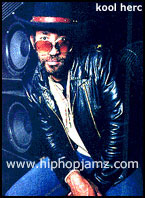|
Hip hop music is related to the griots of West Africa, traveling singers and
poets whose musical style is reminiscent of hip hop. Some griot traditions came
with slaves to the New World. The most important direct influence on the
creation of hip hop music is the Jamaican style called dub, which arose in the
1960s. Dub musicians such as King Tubby isolated percussion breaks because
dancers at clubs (sound systems) preferred the energetic rhythms of the
often-short breaks. Soon, performers began speaking in sync with these rhythms.
In 1967, Jamaican immigrants such as DJ Kool Herc brought dub to New York City,
where it evolved into hip hop. In Jamaica, dub music has diversified into genres
like ragga and dancehall.
 DJ
Kool Herc DJ
Kool Herc
Herc was one of the most popular DJs in early 70s New York, playing at
neighborhood parties (his first gig was on Sedgewick Avenue, Bronx) (block
parties), and he quickly switched from using reggae records to funk, rock and
disco, since the New York audience did not particularly like reggae. Herc and
others DJs extended the percussive breaks using an audio mixer and two records,
and other mixing techniques soon developed. Performers spoke while the music
played; these were originally called MCs (Master of Ceremonies or Mic
Controller) and, later, rappers. These early rappers focused on introducing
themselves and others in the audience, with some improvisation and a simple
four-count beat, along with a simple chorus. Later MCs added more complex
lyrics, often humorous, and incorporated sexual themes. By the end of the 1970s,
hip hop music was beginning to become a major commercial and artistic force and
had spread throughout the United States. During the 1980s and 1990s, hip hop
gradually became mainstream (a transition usually considered to have been
completed in 1992) in the US and, to a lesser degree, worldwide.
credit: wiki |